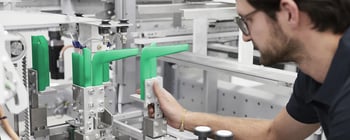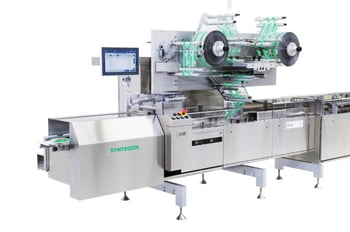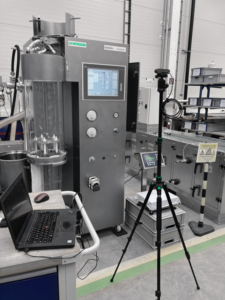We had an opportunity to work with a local high school in New Richmond, WI USA on a special project to prevent the spread of COVID-19 in the classroom. The interview was conducted with Engineering Manager, John Meisner, who works at the Syntegon New Richmond location.
How did the inception of this project come about?
New Richmond High School approached Syntegon in August to see if we could make desk dividers for small group learning pods (groups of four desks). The dividers were to provide a greater level of safety during COVID-19. Syntegon management decided to take the opportunity to assist a school in our community, even if it put additional stress on our business.
A cross-functional team was assembled with engineers, Mitch Gardner and Bryan Mueller, John Noye from procurement, and a teacher from the local high school. The team worked with the school to establish requirements. Eight desks and a chair were supplied by the high school for design and development of a divider prototype.
Was this something you had to consult with the local government or did the school have regulations already in place to consider?
Due to quickly changing COVID-19 best practices, government guidance and established regulations were not yet established for desk dividers. The team referenced examples found on the internet and used team member, Mitch Gardner, as a taller than typical student for divider dimensions. How students sit, move and interact with dividers were all taken into account.
What were some of the challenges faced with designing the concept?
The focus of the initial concept meeting was to find the best solution for a safe and cost-effective divider. The ideas ranged from hanging shower curtains to a free-standing frame. The best design seemed to be a simple desk mounted divider. Bryan Mueller went to work on the clear plastic components, Mitch Gardner started working on the mounts to hold the dividers, and John Noye began looking at material cost, lead time and fabrication capacity.
Mitch and Bryan engineered the components and put together a 3D model of the initial concept. It was quickly reviewed and finalized with a couple of changes. John Noye was able to fast-track the parts and Mitch Gardner used our 3D printer to make the mounts. Changes were needed after the evaluation of the initial prototype. The dividers had to stay in position and be durable enough for a high school environment. For that to happen, the mounts had to be machined aluminum, which put more pressure on our fabrication department.
Once the design was modeled, our production planner, Gary Simon, routed the parts in SAP and worked with our suppliers to get the needed materials as quickly as possible. In fact, the needed polycarbonate went straight from the delivery truck to the router to be cut. Welder, Andy Haugen, and our senior sheetmetal fabricator, Blaine Germain, got the router up to cut out the dividers. After the dividers were cut Blaine Germain, Rich Regan, Bill Aaron, and Tom Marquand all worked together on the shop floor to deburr the polycarbonate parts very quickly.
This was an unusual order for the shop as the order quantities were very high. The volume of the parts got the team thinking and they quickly realized with a couple of small changes to the design that they could produce the aluminum blocks much quicker. Senior machinist, Todd Bottolfson, recognized that a small radius and the length dimension were not critical. He worked with engineering to change the radius and de-tolerance the length which allowed him to machine multiple parts all together to reduce the machining time and then, after machining, Andy cut them to length on the saw. The high order quantity also allowed Todd to run 2 mills at the same time to push the parts out even faster. Through everyone’s efforts, we were even able to deliver early.
What would be your advice for others looking to do the same?
The divider design established in our project is free for others to use if it can help other students have a greater sense of normalcy. However, there may be more research available on design and effectiveness since the installation. Keep in mind, designs are very much desk and desk configuration dependent with size and type differing from school to school.




